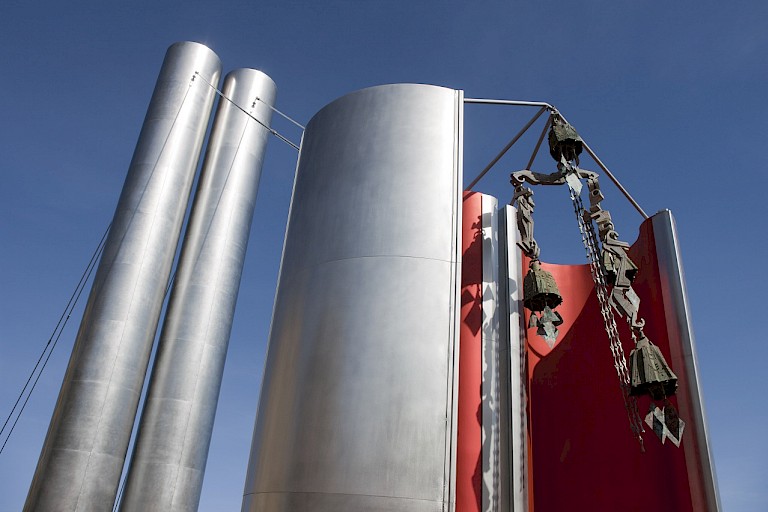



The dynamic project elements reference the range of Soleri’s work: A bridge marks solar events and connects humans conceptually across time; monolithic, earth-cast panels reflect his aesthetic; and the classic bronze bells, which have supported Soleri’s projects, are recognized internationally.
The bridge is anchored by two 64-foot pylons and is twenty-seven feet wide on the south side narrowing to eighteen feet on the north. Situated at a true north axis, the bridge is intended to mark solar events produced by the sun’s shadow. The six-inch gap between both sets of pylons allows the sun to create a shaft of light as the earth moves. At each solar noon—which can vary up to 40 minutes from twelve o’clock noon—light coming through the gap produces a shadow. The length of this shaft of light varies depending upon the time of year.
At each summer solstice (June 21st) when the sun is highest in the sky, no shadow is cast; while at each winter solstice (December 21st) when the sun is lowest in the sky, the shadow is the longest, reaching to the bridge structure. A red stripe along the length of the bridge deck follows the light and perceptually leads the viewer across the bridge. The bridge and plaza also celebrate the annual equinox events that are approximately on Setpember 21st and March 22nd.
The 22,000 square foot plaza includes totemic panels replicating the cast wall motif representative of Cosanti and Arcosanti, Soleri’s major architectural projects. Each 3500-pound panel was individually designed by Dr. Soleri with Roger Tomalty and produced at Cosanti in Scottsdale, Arizona. The ten earth cast panels framing the southern boundary of the plaza use the illinoidal shape in various iterations with earth color pigments accentuating the various designs. A larger, eleventh panel frames the north side of the bridge. The earth cast process uses the desert earth with water and cement, which is then carved, before being cast in concrete and allowed to cure. The fabrication of these panels took nearly eight months.
The strong architectural carving on the panels creates a perfect counterpoint for the Goldwater Bell assembly, which reflects Soleri’s life work in architecture and ecology. Fabricated entirely by Paolo Soleri in 1969, the bell was part of the artist’s first U.S. retrospective at the Corcoran Gallery in Washington, DC. Encased within the 22-foot tall pylons near the south edge of the plaza, the bell and the panels create an intimate gallery setting amidst the open plaza.
All copyright belongs to Shanghai Academy of Fine Arts, Shanghai University.

